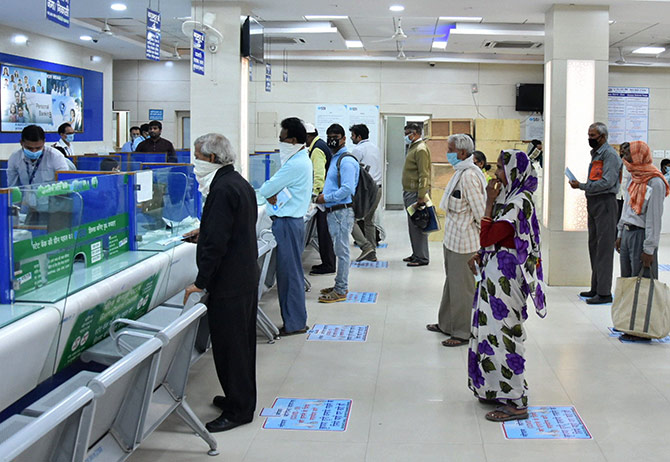 | « Back to article | Print this article |
While banks are not as exposed as the corporate sector during the initial stage of the pandemic, the strain on lenders could ultimately be profound. Banks face a second-order hit compared with the corporate and household sectors.

Banks in the country are likely to witness a spike in their non-performing assets ratio by 1.9 per cent and credit cost ratios by 130 basis point in 2020, following the economic slowdown on account of COVID-19 crisis, says a report.
In its report titled "For Asia-Pacific Banks, COVID-19 Crisis Could Add $300 billion To Credit Costs" S&P Global Ratings said, it expects the non-performing assets (NPA) ratio for the Chinese banking sector to increase by about 2 per cent in 2020, and credit losses, to increase by about 100 basis points.
On India, the report said "the NPA ratio in India is likely to fare similarly to China's (1.9 per cent vs 2 per cent) but the credit costs ratios could be worse, increasing by about 130 basis points," the rating agency's credit analyst Gavin Gunning said in the report.
Gunning said there are concerns that the coronavirus will spread faster, further, and for longer.
"This will deepen the economic pain we already anticipate for 2020. Financing conditions may likewise sour as investors become more risk averse. This would hit bank credit," he said.
The report noted that an additional $300 billion spike in lenders' credit costs and a $600 billion increase in (NPAs) will occur in 2020 due to the adverse impact of coronavirus pandemic.
While banks are not as exposed as the corporate sector during the initial stage of the pandemic, the strain on lenders could ultimately be profound.
Banks face a second-order hit compared with the corporate and household sectors.
The report said the economic storm created by COVID-19 will test the ratings resilience of the region's 20 banking sectors.
"The resilience of banks' asset quality in 2020 hinges in part on the success of governments' and regulators' policy responses.
“These measures are in early stages. Some have started, some are in planning, and we suspect many more may be in the wings," Gunning said.
Asia-Pacific governments, central banks, and supervisory authorities have rolled out diverse measures to address COVID-19.
These include liquidity injections, targeted loans to affected industries and regions, and policy rate cuts.
It also includes support for banks to provide forbearance to otherwise economically viable households and businesses sideswiped by COVID-19.
The RBI in its seventh bi-monthly monetary policy announced on March 27, reduced the repo rate by 75 basis points to 4.40 per cent.
It announced to provide Rs 3.74 lakh crore liquidity to banks through reduction in cash reserve ratio, by conducting targeted long term repos operations (TLTRO) and by increasing the limit for marginal standing facility (MSF) to 3 per cent.
RBI also allowed a repayment moratorium for three months on all term loans outstanding as on March 1, 2020, to borrowers of all commercial banks, including regional rural banks, small finance banks and local area banks, co-operative banks, and NBFCs, including housing finance companies and micro-finance institutions.
"The equation underpinning policy responses is simple in theory but difficult in practice, and always comes at a significant fiscal cost," Gunning noted.